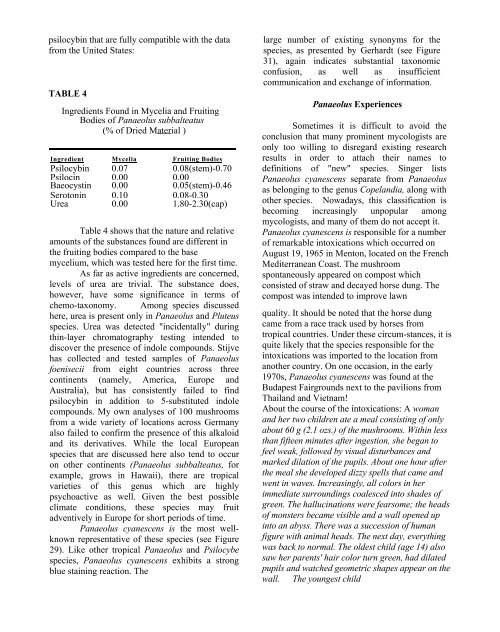Jochen Gartz - Magic Mushrooms Around the ... - preterhuman.net
Jochen Gartz - Magic Mushrooms Around the ... - preterhuman.net
Jochen Gartz - Magic Mushrooms Around the ... - preterhuman.net
You also want an ePaper? Increase the reach of your titles
YUMPU automatically turns print PDFs into web optimized ePapers that Google loves.
psilocybin that are fully compatible with <strong>the</strong> data<br />
from <strong>the</strong> United States:<br />
TABLE 4<br />
Ingredients Found in Mycelia and Fruiting<br />
Bodies of Panaeolus subbalteatus<br />
(% of Dried Material )<br />
Ingredient Mycelia<br />
Fruiting Bodies<br />
Psilocybin 0.07 0.08(stem)-0.70<br />
Psilocin 0.00 0.00<br />
Baeocystin 0.00 0.05(stem)-0.46<br />
Serotonin 0.10 0.08-0.30<br />
Urea 0.00 1.80-2.30(cap)<br />
Table 4 shows that <strong>the</strong> nature and relative<br />
amounts of <strong>the</strong> substances found are different in<br />
<strong>the</strong> fruiting bodies compared to <strong>the</strong> base<br />
mycelium, which was tested here for <strong>the</strong> first time.<br />
As far as active ingredients are concerned,<br />
levels of urea are trivial. The substance does,<br />
however, have some significance in terms of<br />
chemo-taxonomy. Among species discussed<br />
here, urea is present only in Panaeolus and Pluteus<br />
species. Urea was detected "incidentally" during<br />
thin-layer chromatography testing intended to<br />
discover <strong>the</strong> presence of indole compounds. Stijve<br />
has collected and tested samples of Panaeolus<br />
foenisecii from eight countries across three<br />
continents (namely, America, Europe and<br />
Australia), but has consistently failed to find<br />
psilocybin in addition to 5-substituted indole<br />
compounds. My own analyses of 100 mushrooms<br />
from a wide variety of locations across Germany<br />
also failed to confirm <strong>the</strong> presence of this alkaloid<br />
and its derivatives. While <strong>the</strong> local European<br />
species that are discussed here also tend to occur<br />
on o<strong>the</strong>r continents (Panaeolus subbalteatus, for<br />
example, grows in Hawaii), <strong>the</strong>re are tropical<br />
varieties of this genus which are highly<br />
psychoactive as well. Given <strong>the</strong> best possible<br />
climate conditions, <strong>the</strong>se species may fruit<br />
adventively in Europe for short periods of time.<br />
Panaeolus cyanescens is <strong>the</strong> most wellknown<br />
representative of <strong>the</strong>se species (see Figure<br />
29). Like o<strong>the</strong>r tropical Panaeolus and Psilocybe<br />
species, Panaeolus cyanescens exhibits a strong<br />
blue staining reaction. The<br />
large number of existing synonyms for <strong>the</strong><br />
species, as presented by Gerhardt (see Figure<br />
31), again indicates substantial taxonomic<br />
confusion, as well as insufficient<br />
communication and exchange of information.<br />
Panaeolus Experiences<br />
Sometimes it is difficult to avoid <strong>the</strong><br />
conclusion that many prominent mycologists are<br />
only too willing to disregard existing research<br />
results in order to attach <strong>the</strong>ir names to<br />
definitions of "new" species. Singer lists<br />
Panaeolus cyanescens separate from Panaeolus<br />
as belonging to <strong>the</strong> genus Copelandia, along with<br />
o<strong>the</strong>r species. Nowadays, this classification is<br />
becoming increasingly unpopular among<br />
mycologists, and many of <strong>the</strong>m do not accept it.<br />
Panaeolus cyanescens is responsible for a number<br />
of remarkable intoxications which occurred on<br />
August 19, 1965 in Menton, located on <strong>the</strong> French<br />
Mediterranean Coast. The mushroom<br />
spontaneously appeared on compost which<br />
consisted of straw and decayed horse dung. The<br />
compost was intended to improve lawn<br />
quality. It should be noted that <strong>the</strong> horse dung<br />
came from a race track used by horses from<br />
tropical countries. Under <strong>the</strong>se circum-stances, it is<br />
quite likely that <strong>the</strong> species responsible for <strong>the</strong><br />
intoxications was imported to <strong>the</strong> location from<br />
ano<strong>the</strong>r country. On one occasion, in <strong>the</strong> early<br />
1970s, Panaeolus cyanescens was found at <strong>the</strong><br />
Budapest Fairgrounds next to <strong>the</strong> pavilions from<br />
Thailand and Vietnam!<br />
About <strong>the</strong> course of <strong>the</strong> intoxications: A woman<br />
and her two children ate a meal consisting of only<br />
about 60 g (2.1 ozs.) of <strong>the</strong> mushrooms. Within less<br />
than fifteen minutes after ingestion, she began to<br />
feel weak, followed by visual disturbances and<br />
marked dilation of <strong>the</strong> pupils. About one hour after<br />
<strong>the</strong> meal she developed dizzy spells that came and<br />
went in waves. Increasingly, all colors in her<br />
immediate surroundings coalesced into shades of<br />
green. The hallucinations were fearsome; <strong>the</strong> heads<br />
of monsters became visible and a wall opened up<br />
into an abyss. There was a succession of human<br />
figure with animal heads. The next day, everything<br />
was back to normal. The oldest child (age 14) also<br />
saw her parents' hair color turn green, had dilated<br />
pupils and watched geometric shapes appear on <strong>the</strong><br />
wall. The youngest child








![The Big Lie 9-11 and Government Complicity in Mass Murder [PDF]](https://img.yumpu.com/50957077/1/190x245/the-big-lie-9-11-and-government-complicity-in-mass-murder-pdf.jpg?quality=85)








